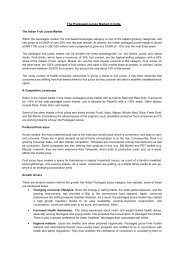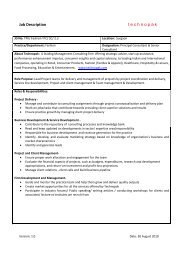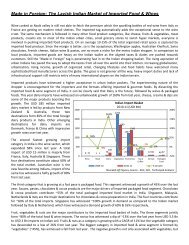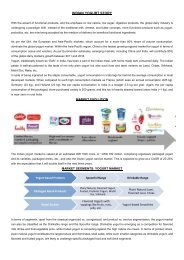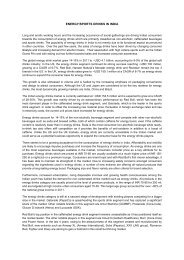a quarterly report by - Technopak
a quarterly report by - Technopak
a quarterly report by - Technopak
Create successful ePaper yourself
Turn your PDF publications into a flip-book with our unique Google optimized e-Paper software.
perspective<br />
a quar terly repor t <strong>by</strong><br />
Volume 02 / 2009<br />
| Volume 02<br />
• Table 1: Suppose a firm currently does a stock transfer from State A to State B, before selling in State<br />
B to avoid paying CST. It thus gets a margin of US$ 0.50 per unit and incurs local VAT only when it sells<br />
in State B to its distributor through its depot. The distributor charges a margin of US$ 0.14 per unit and<br />
charges the final price <strong>by</strong> adjusting the input credit (which is available since the sale from depot was<br />
intra-state). In this case,<br />
Price to Retailer = (Distributor Landed Cost + Distributor Margin – Distributor Input Credit) * (1 + VAT<br />
Rate).<br />
Similarly the MRP comes out to US$ 3.13/unit after accounting for input credit at retail level as well as<br />
retailers’ US$ 0.28 /unit margin.<br />
• Table 2: In today’s 2% CST scenario, the firm incurs US$ 0.08/unit loss in margin if it were to do a crossborder<br />
sale to the distributor, without going through a stock transfer at the depot. The calculations are<br />
based on the premise that the US$/unit retailer margin, distributor margin and MRP are maintained at the<br />
same level.<br />
•Table 3: If CST rates were to become zero then the firm can do cross-border sale (at 0% rate) directly to<br />
the distributor without any loss of margin to itself, the distributor or the retailer and yet charge the same<br />
MRP to the consumer.<br />
•Table 4: If CST is abolished and inter-state sales or stock transfers are taxed with input credit allowed at<br />
the destination, then also the margins and MRP remain intact for everyone.<br />
Thus, we see that when tax barriers on cross-border<br />
sales are removed whether through the route shown<br />
in Table 3 or 4, it becomes unnecessary to have<br />
a depot in the destination state. The supply chain<br />
can then be designed not on tax considerations<br />
but purely on logistics cost and customer service<br />
considerations.<br />
Exhibit 5<br />
Approximate Number of Warehouses Needed<br />
in the GST Scenario<br />
Delivery Lead Time for 80% Urban<br />
Customers<br />
Annual Turnover (US$ Mn ) 24 Hrs 48 Hrs<br />
< 600 24 - 28 20 - 24<br />
600 - 1500 22 - 26 18 - 22<br />
Hence, a key feature of post GST supply chain<br />
networks would be fewer warehouses or distribution > 1500 20 - 24 16 - 20<br />
centres than before. This means simpler and leaner<br />
Source: <strong>Technopak</strong> analysis<br />
networks which could incur lower costs of operation as explained below. Exhibit 5 provides an approximate<br />
guide on the number of warehouses for a distribution company dealing in fast moving goods can have in<br />
a GST scenario. The specific business realities of the company will also have a great bearing on the actual<br />
number of warehouses required.<br />
Network Re-engineering for GST<br />
We have already established that an optimum network design post GST would be different from an optimum<br />
network design in today’s taxation scenario. The re-organised network will in fact be significantly different.<br />
•The<br />
move towards fewer warehouses would require many warehouses to combine, close and re-locate.<br />
•Required<br />
capacity of many warehouses will undergo changes. With fewer warehouses, the average size<br />
of the warehouse will go up.<br />
•Hubs<br />
are not directly impacted <strong>by</strong> CST considerations. However, fewer & larger warehouses may make<br />
it feasible to route plant production directly to warehouses rather than through hubs, due to larger<br />
throughputs. Thus, the size and number of hubs could get affected.<br />
•The<br />
linkages between factories-hubs-warehouses-customers for various products will get re-aligned.<br />
GST : Impact on the Supply Chain |<br />
26



